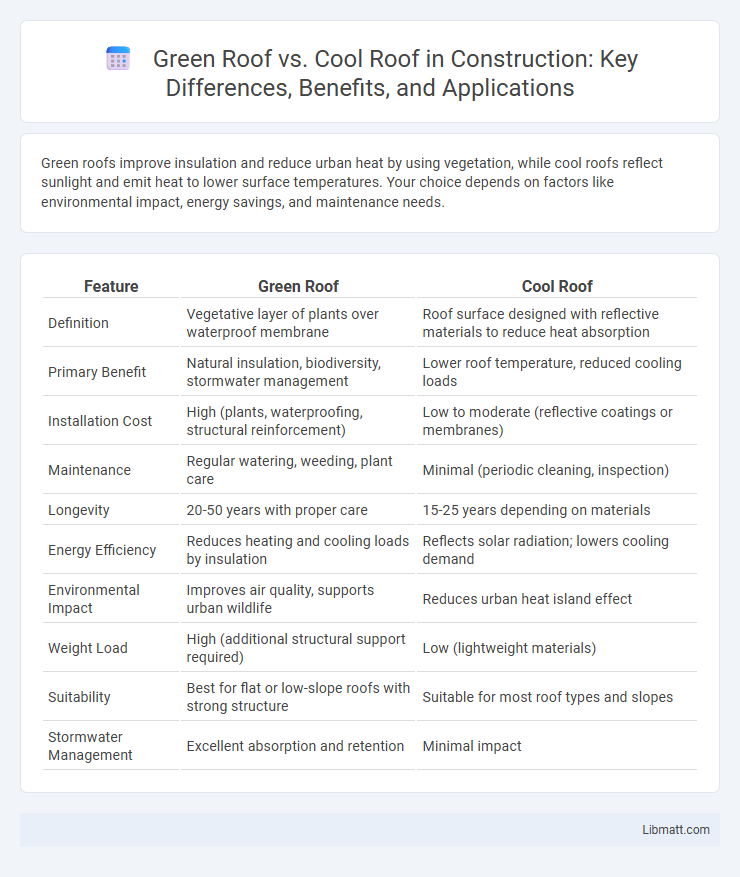Green roofs improve insulation and reduce urban heat by using vegetation, while cool roofs reflect sunlight and emit heat to lower surface temperatures. Your choice depends on factors like environmental impact, energy savings, and maintenance needs.
Table of Comparison
| Feature | Green Roof | Cool Roof |
|---|---|---|
| Definition | Vegetative layer of plants over waterproof membrane | Roof surface designed with reflective materials to reduce heat absorption |
| Primary Benefit | Natural insulation, biodiversity, stormwater management | Lower roof temperature, reduced cooling loads |
| Installation Cost | High (plants, waterproofing, structural reinforcement) | Low to moderate (reflective coatings or membranes) |
| Maintenance | Regular watering, weeding, plant care | Minimal (periodic cleaning, inspection) |
| Longevity | 20-50 years with proper care | 15-25 years depending on materials |
| Energy Efficiency | Reduces heating and cooling loads by insulation | Reflects solar radiation; lowers cooling demand |
| Environmental Impact | Improves air quality, supports urban wildlife | Reduces urban heat island effect |
| Weight Load | High (additional structural support required) | Low (lightweight materials) |
| Suitability | Best for flat or low-slope roofs with strong structure | Suitable for most roof types and slopes |
| Stormwater Management | Excellent absorption and retention | Minimal impact |
Introduction to Green Roofs and Cool Roofs
Green roofs consist of vegetation layers planted over waterproof membranes, providing natural insulation, stormwater management, and urban heat reduction. Cool roofs use reflective materials designed to reflect more sunlight and absorb less heat than standard roofs, lowering building temperatures and energy costs. When choosing between green roofs and cool roofs, your decision depends on factors like climate, budget, and environmental benefits you prioritize.
Key Differences Between Green Roofs and Cool Roofs
Green roofs consist of vegetation layers that provide insulation, reduce urban heat islands, and improve air quality through natural processes. Cool roofs use reflective materials to minimize heat absorption, lowering building temperatures and energy costs by reflecting sunlight. Understanding these key differences helps you select the optimal roofing solution for energy efficiency and environmental impact.
Benefits of Green Roof Systems
Green roof systems provide numerous environmental and economic benefits, including improved air quality, reduced urban heat island effect, and enhanced stormwater management by absorbing rainwater. They contribute to energy savings by insulating buildings, lowering heating and cooling costs, and extending roof lifespan by protecting roofing materials from UV damage. You can also promote biodiversity and create urban green spaces, improving overall ecosystem health and enhancing property value.
Advantages of Cool Roof Technologies
Cool roof technologies significantly reduce urban heat island effects by reflecting more sunlight and absorbing less heat than traditional roofing materials, leading to lower building temperatures. These roofs enhance energy efficiency by decreasing the need for air conditioning, which results in reduced electricity consumption and lower greenhouse gas emissions. Cool roofs also extend the lifespan of roofing materials by minimizing thermal expansion and contraction, reducing maintenance costs over time.
Installation Requirements for Green and Cool Roofs
Green roof installation involves laying a waterproof membrane, root barrier, drainage layers, and a growing medium to support vegetation, requiring structural reinforcement to handle the increased weight. Cool roofs typically need reflective coatings or materials such as white elastomeric paint, reflective shingles, or tiles, which can be applied over existing roofs with minimal structural adjustment. Proper installation of green roofs demands professional expertise for irrigation and maintenance systems, whereas cool roofs emphasize surface preparation and ensuring adequate reflectivity for optimal energy efficiency.
Energy Efficiency Comparison
Green roofs provide superior energy efficiency by offering natural insulation and reducing heat absorption through vegetation layers, which lowers cooling costs significantly in warm climates. Cool roofs use reflective materials to bounce sunlight away, decreasing surface temperatures and energy consumption for air conditioning. Your choice between green and cool roofs should consider maintenance, climate, and the extent of energy savings desired for optimizing building performance.
Environmental Impact and Sustainability
Green roofs enhance environmental sustainability by promoting biodiversity, reducing urban heat islands, and improving air quality through vegetation. Cool roofs reflect sunlight and reduce building temperatures, lowering energy consumption and greenhouse gas emissions. Your choice between green and cool roofs depends on local climate, ecological goals, and maintenance capacity for optimal environmental impact.
Cost Analysis: Green Roof vs Cool Roof
Green roofs generally involve higher installation and maintenance costs, typically ranging from $15 to $30 per square foot, due to complex waterproofing, soil layers, and vegetation requirements. Cool roofs, by contrast, are more cost-effective initially, averaging $5 to $12 per square foot, with lower maintenance expenses since they primarily use reflective coatings or materials. Long-term energy savings and potential stormwater management benefits can offset green roof costs, while cool roofs primarily reduce cooling expenses by reflecting solar radiation.
Maintenance Needs and Longevity
Green roofs require regular maintenance such as watering, weeding, and inspecting plant health to ensure longevity, typically lasting 30 to 50 years if properly cared for. Cool roofs, on the other hand, need minimal upkeep, usually involving periodic cleaning and inspection, with a lifespan of around 15 to 25 years depending on the materials used. Your choice between the two should consider the trade-off between ongoing maintenance efforts and the expected durability of the roofing system.
Choosing the Right Roof for Your Building
Selecting the right roof involves comparing the energy savings and environmental benefits of green roofs and cool roofs. Green roofs provide superior insulation, reduce stormwater runoff, and promote biodiversity through vegetation layers, making them ideal for urban buildings seeking sustainability. Cool roofs, coated with reflective materials, effectively lower rooftop temperatures and decrease cooling costs, offering a cost-effective solution for hot climates with less structural load.
Green roof vs Cool roof Infographic

 libmatt.com
libmatt.com